
Uppland Runic Inscription 1145, or U 1145 in the Rundata catalog, is a Viking Age memorial runestone that is located near the town of Tierp in Uppland, Sweden.

Uppland Runic Inscription 1145, or U 1145 in the Rundata catalog, is a Viking Age memorial runestone that is located near the town of Tierp in Uppland, Sweden.
U 1145, which consists of a serpent that circles a cross, is classified as being carved in either runestone style Pr2 or Pr3. The text states that Ríkr and Gunnthrúðr raised the stone in memory of Fasti. The text ends in a prayer which uses the Norse word salu for soul, which was borrowed from English and was first used in another inscription during the tenth century. [1] The runes in the prayer follow the rule that double letters are represented with only a single rune, even if one of the two letters are at the end of one word and the second is at the beginning of the next word. [2] In U 1145 this rule applies to four consecutive words in the prayer, which are written as honsalukuþs on the stone. The transliteration of the runic text for these words in the prayer, hons| |salu| |uk| |kuþs, shown below shows word divisions and a separate s, u, and k rune for each of the words.
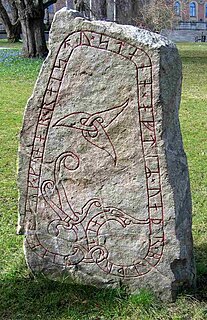
The Funbo runestones constitute a group of four runestones originally from Funbo in the province of Uppland, Sweden, which were raised by members of the same family during the eleventh century.

Uppland Runic Inscription 701 or U 701, and also known as Kynge stone, is a runestone that is now lost. It was recorded in a drawing in the 17th century by Johan Hadorph and P. Helgonius, as well as Johannes Haquini Rhezelius. Richard Dybeck took up the search for the missing U 701 in 1860 but was not able to find it. It is believed that U 701 was carved by the artist who made runic inscriptions U 700 and U 702. The recorded text ends with a prayer that uses the Norse word salu for soul, which was imported from English and first used on a different inscription during the tenth century.
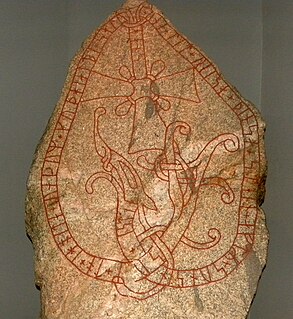
Uppland Runic Inscription 613, also known as the Torsätra runestone, is the Rundata catalog number for a Viking Age memorial runestone originally located in Torsätra, which is approximately 8 kilometers northeast of Bro, Stockholm County, Sweden, which is in the historic province of Uppland.

The Eggeby stone, designated as U 69 under the Rundata catalog, is a Viking Age memorial runestone that is located at Eggeby, which is 2 kilometers northwest of Central Sundbyberg, Sweden, which was in the historic province of Uppland.

The Hakon Jarl Runestones are Swedish runestones from the time of Canute the Great.

The Ingvar Runestones is the name of around 26 Varangian Runestones that were raised in commemoration of those who died in the Swedish Viking expedition to the Caspian Sea of Ingvar the Far-Travelled.
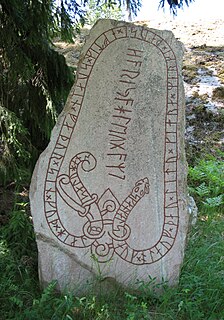
The Skåäng Runestone, designated as Sö 32 under Rundata, is an Iron Age runestone located in Skåäng, Södermanland, Sweden, which is inscribed in Proto-Norse with the elder futhark. During the Viking Age, a second runic inscription was added in Old Norse using the younger futhark.

The Lingsberg Runestones are two 11th-century runestones, listed as U 240 and U 241 in the Rundata catalog, and one fragment, U 242, that are engraved in Old Norse using the younger futhark. They are at the Lingsberg farm about 2 kilometres (1.2 mi) east of Vallentuna, which is about 24 kilometres (15 mi) north of the center of Stockholm, Stockholm County, Sweden, which was part of the former province of Uppland.

The Greece runestones are about 30 runestones containing information related to voyages made by Norsemen to the Byzantine Empire. They were made during the Viking Age until about 1100 and were engraved in the Old Norse language with Scandinavian runes. All the stones have been found in modern-day Sweden, the majority in Uppland and Södermanland. Most were inscribed in memory of members of the Varangian Guard who never returned home, but a few inscriptions mention men who returned with wealth, and a boulder in Ed was engraved on the orders of a former officer of the Guard.
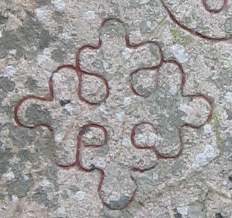
The Risbyle Runestones are two runestones found near the western shore of Lake Vallentunasjön in Uppland, Sweden, dating from the Viking Age.
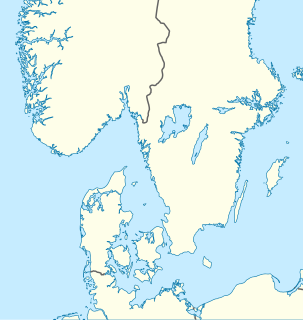
The England runestones are a group of about 30 runestones in Northern Europe which refer to Viking Age voyages to England. They constitute one of the largest groups of runestones that mention voyages to other countries, and they are comparable in number only to the approximately 30 Greece Runestones and the 26 Ingvar Runestones, of which the latter refer to a Viking expedition near the Caspian Sea. They were engraved in Old Norse with the Younger Futhark.

The Viking runestones are runestones that mention Scandinavians who participated in Viking expeditions. This article treats the runestone that refer to people who took part in voyages abroad, in western Europe, and stones that mention men who were Viking warriors and/or died while travelling in the West. However, it is likely that all of them do not mention men who took part in pillaging. The inscriptions were all engraved in Old Norse with the Younger Futhark. The runestones are unevenly distributed in Scandinavia: Denmark has 250 runestones, Norway has 50 while Iceland has none. Sweden have as many as between 1,700 and 2,500 depending on definition. The Swedish district of Uppland has the highest concentration with as many as 1,196 inscriptions in stone, whereas Södermanland is second with 391.

The Baltic area runestones are Varangian runestones in memory of men who took part in peaceful or warlike expeditions across the Baltic Sea, where Finland and the Baltic states are presently located.

U 1043 is the Rundata designation for a runic inscription on a memorial runestone located in Onslunda, Tensta parish, and about four kilometers west of Vattholma, Sweden, which was in the historic province of Uppland. While the tradition of carving inscriptions into boulders began in the 4th century and lasted into the 12th century, most runestones date from the late Viking Age.

Uppland Runic Inscription 1144 or U 1144 is the Rundata catalog designation of a Viking Age memorial runestone in a churchyard that is located five kilometers southwest of Tierp, Uppsala County, Sweden, which was in the historic province of Uppland.

Runic inscription U 873 is the Rundata catalog number for a Viking Age memorial runestone that is located in Örsunda, which is about one kilometer west of Örsundsbro, Uppsala County, Sweden, which is in the historic province of Uppland.

This runic inscription, designated as U Fv1976;104 in the Rundata catalog, is on a Viking Age memorial runestone that is located at the Uppsala Cathedral, Uppland, Sweden.
The Lilla Vilunda runestones are three Viking Age memorial runestones that were erected by members of the same family and which are located at Lilla Vilunda in Upplands Väsby, Stockholm County, Sweden, and in the historic province of Uppland.

Uppland Runic Inscription 130 or U 130 is the Rundata catalog listing for a Viking Age memorial runic inscription which is located at Nora, which is in Danderyd, Stockholm County, Sweden, and in the historic province of Uppland. The runic text directly refers to an estate held in an allodial title.
The Uppland Runic Inscription 954 is a Viking Age runestone engraved in Old Norse with the Younger Futhark runic alphabet. It was found by Johannes Bureus, but it has disappeared. It was located near Danmark Church in Uppsala Municipality. The style is possibly Pr1.